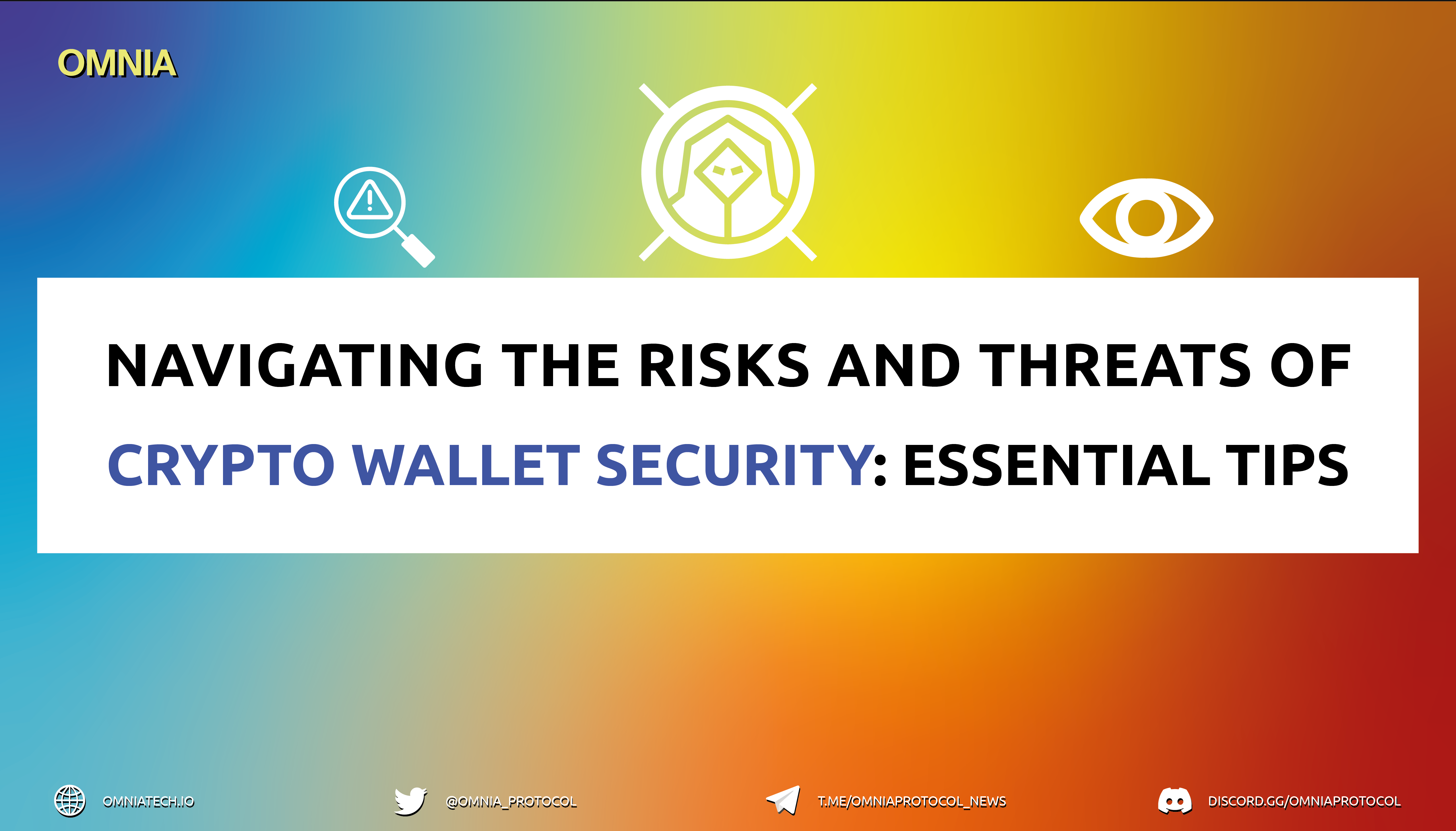
Navigating the Risks and Threats of Crypto Wallet Security: Essential Tips
The Importance of Crypto Wallet Security
Crypto wallets offer varying levels of security, and users must select the type of wallet that best aligns with their security and availability requirements. For instance, if a user needs to use their addresses and keys frequently and online, hardware wallets may not be suitable. Conversely, desktop wallets may not be useful for users who need to access their crypto wallets while on the go, such as in a retail store. While generally considered more secure than software wallets, hardware wallets may still be susceptible to hardware failures, attacks, and theft. In contrast, software wallets are vulnerable to software failures and network attacks. Additionally, hardware failures of mobile, desktop, or cloud platforms can impact the performance of software wallets.
A crypto wallet can be considered a single point of failure since it utilizes private keys for authenticating coin ownership. To improve security, multi-signature wallets (or “multi-sig” wallets) have been developed that require more than one signature to access coins. Online wallets or cryptocurrency exchanges often utilize these wallets to mitigate the security risks associated with losing or capturing private keys; Coins can only be accessed by utilizing two or more signatures, which significantly increases the difficulty of stealing. Even if one of the private keys is compromised or lost, the owner can still access their wallet with the remaining keys. This added security feature ensures that unauthorized parties cannot access the wallet and reduces the risk of loss or theft of valuable assets.
It is expected that cryptocurrency exchanges will become increasingly attractive targets for attacks in the near future. Given the high stakes involved, exchanges and end-users seek reliable solutions and products to manage their sensitive information securely. While the blockchain infrastructure of exchanges may be secure, the security of their wallets ultimately depends on the protection of private keys. As exchanges are connected to the internet and serve many users, online wallets are particularly vulnerable to attacks by hackers. End-users know this vulnerability and seek solutions to safeguard their crypto assets against theft or loss.
Tips to Increase Crypto Wallet Security
Unauthorized access, eavesdropping, DDoS attacks, and vulnerabilities in nodes and endpoints are all potential security threats that can affect the security of crypto wallets. It is important to understand the potential application flaws in crypto wallets as well as apply tips in order to increase the level of security.
Essential Tip #1: How to Prevent Unauthorized Access to Your Crypto Wallet
- The Problem:
- An attacker or malicious user could gain unauthorized access to a lost or stolen wallet by bypassing any PIN or fingerprint lock, thereby obtaining root access to reveal wallet data. They may exploit any weak authentication mechanisms to gain access to the wallet.
- The wallet application’s security mechanism must provide an appropriate level of authorization complexity to prevent unauthorized access to the assets. The wallet should control access to its functionalities and may employ two-factor or multifactor authentication. Utilizing two factors, such as double authenticating, provides an extra layer of security compared to using a single password, PIN, or biometric data.
- OMNIA’s Solution:
- OMNIA has security and privacy in place to prevent unauthorized access in the form of protecting data, monitoring, and health checks. The OMNIA infrastructure consists of blockchain nodes and privacy relayers that function as decentralized API gateways for accessing the blockchain. Although these roles are not mutually exclusive, in the case where an entity holds both the relayer and node owner roles, any request directed at that particular relayer will be redirected to another node owner to maintain the confidentiality of the infrastructure layer.
- How to secure your wallet? Go to https://omniatech.io and click Get Public RPC button, then select your desired network and add to MetaMask. It’s just a few clicks and takes less than one minute. (tutorial)
Essential Tip #2: How to Prevent Eavesdropping
- The Problem:
- An attacker can eavesdrop on existing communication between a wallet and interface or any other application and may use replay or man-in-the-middle attacks to capture identification and authentication data to gain access to the system.
- To prevent attackers from revealing confidential data or gaining unauthorized access via eavesdropping, the security functionality of wallets should keep communication obfuscated and encrypted. Implementing cryptographic operations within the secure boundary of the wallet could be an additional protection mechanism against this type of attack.
- OMNIA’s Solution:
- OMNIA provides protection for DDos attacks on both nodes and endpoints by using load balancers and firewalls. Node owners can register their nodes through a simple-to-use web interface provided by Omnia. Consequently, these nodes are indexed by the relayers who leverage mixnets to protect privacy, which allows for timing obfuscation and decoy traffic injection to guarantee the utmost privacy.
- How to secure your wallet? Go to https://omniatech.io and click Get Public RPC button, then select your desired network and add to MetaMask. It’s just a few clicks and takes less than one minute. (tutorial)
Essential Tip #3: How to Prevent DDoS Attacks
- The Problem:
- A DDdS attack on a Blockchain system occurs when an attacker attempts to disable the system by inundating it with an overwhelming amount of requests quickly, thereby consuming all its processing resources. The attacker aims to disconnect mining pools, e-wallets, or cryptocurrency exchanges.
- In some rare cases, non-custodial wallets can contribute to DDoS attacks on individual nodes or entire blockchains. This occurs when a cryptocurrency solution lacks a middleware entity, such as a crypto wallet backend server, that can filter and validate transactions. Without this layer, malformed transactions can be sent directly to the blockchain, wasting nodes’ resources and preventing valid transactions from being processed.
- An attacker may execute a denial of service attack using tools and infected computers to degrade the connection quality between a wallet and the blockchain network, rendering wallet services inaccessible. This attack is made possible by exploiting bugs or weaknesses in the software implementation.
- Attacks causing a denial of service on individual nodes or the entire blockchain network are common in the crypto world. Many wallet apps connect to the blockchain network directly without firewalls. By sending malformed transactions, attackers can overload blockchain nodes with useless computations, leading to a denial of service.
- OMNIA’s Solution:
- OMNIA provides protection for DDos attacks on both nodes and endpoints by using load balancers, firewalls and services like Cloudflare. We have enhanced the existing centralized directory authority used for routing in mixnets to a consensus based approach in order to mitigate the single point of failure in case of directory corruption. In addition to that, Cloudflare, a global network ensuring privacy, security, and reliability helps to ensure you can stay connected and maintain business continuity, even in the face of an attack. The industry-leading solution is able to mitigate malicious traffic in less than 3 seconds.
- How to secure your wallet? Go to https://omniatech.io and click Get Public RPC button, then select your desired network and add to MetaMask. It’s just a few clicks and takes less than one minute. (tutorial)
Essential Tip #4: How to Secure your Crypto Wallets with OMNIA
Eavesdropping and DDos, nodes and endpoints are possible security threats that OMNIA can prevent. Although these security threats may not be so apparent to the end user, they are a prominent part of transactions and users must take the extra precautions to be educated against such vulnerabilities. Although not many applications are out there as a single stop solution, OMNIA is breaking in and filling this gap for both wallet providers, as well as individual wallet owners who want to take the extra steps to have a secure wallet, without worrying about the worst thing that could happen every single time a transfer is made.
- In the case of wallet providers, if OMNIA is used as an RPC node provider, our job is to make sure nodes do not get attacked. As a result, users receive access to secure RPC endpoints (either HTTP or WSS) for any of the blockchain networks that we support, and get protection from malicious activities.
- OMNIA provides you a secure RPC endpoint with high availability to access the blockchain without being traced.

